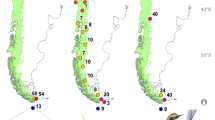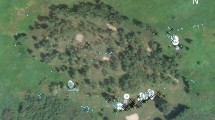Abstract
The African lark genus Heteromirafra is thought to consist of three threatened species inhabiting mid-altitude grasslands, one in South Africa and two in the Horn of Africa. One of the latter, Archer’s Lark H. archeri of Somaliland, has not been seen with certainty since 1922. We surveyed its type locality as well as a nearby area of grassland east of Jijiga in adjacent north-eastern Ethiopia, where sightings of Heteromirafra larks have recently been made. First, we used a combination of morphological and molecular evidence to show that these recent sightings refer to the same taxon as Archer’s Lark. Second, we used a combination of morphological, molecular and vocal evidence to show that these populations are conspecific with the Liben (Sidamo) Lark H. sidamoensis of southern Ethiopia, but that the Horn of Africa populations are highly distinct from Rudd’s Lark H. ruddi of South Africa. Third, we suggest that the extent and quality of their habitat in north-eastern Ethiopia is small and poor, and that the type locality of Archer’s Lark in Somaliland has been completely transformed. Taken together, these results imply that there is a single species of Heteromirafra in the Horn of Africa (for which the scientific name H. archeri has priority, and which we suggest retains the English name Liben Lark), consisting of two tiny populations separated by 590 km of apparently unsuitable habitats. Environmental niche models suggest that there are no environmentally similar locations elsewhere within the region. Despite the discovery of a second population, the Liben Lark remains a highly threatened species in urgent need of conservation intervention to avert the extinction of both of its populations.
Zusammenfassung
Die Wiederentdeckung einer lange verschollenen Lerchenart belegt die Konspezifität der gefährdeten Heteromirafra -Populationen am Horn von Afrika
Die afrikanische Lerchengattung Heteromirafra besteht Annahmen zufolge aus drei bedrohten Arten, die Grasland in mittleren Höhenstufen besiedeln—eine davon in Südafrika, die zwei anderen am Horn von Afrika. Eine der beiden letzteren, die Somalispornlerche H. archeri, konnte in Somaliland seit 1922 nicht mehr mit Sicherheit nachgewiesen werden. Wir untersuchten sowohl die Typuslokalität als auch ein benachbartes Graslandgebiet östlich von Jijiga im angrenzenden Nordost-Äthiopien, wo kürzlich Heteromirafra-Lerchen gesichtet wurden. Erstens konnten wir durch eine Kombination aus morphologischen und molekularen Anhaltspunkten zeigen, dass es sich bei diesen neuerlichen Beobachtungen um dasselbe Taxon wie die Somalispornlerche handelt. Zweitens gelang es, mittels einer Kombination aus morphologischen, molekularen und bioakustischen Hinweisen zu belegen, dass diese Populationen konspezifisch mit der Sidamospornlerche H. sidamoensis des südlichen Äthiopiens sind, sich die Populationen am Horn von Afrika aber deutlich von der Transvaalspornlerche H. ruddi in Südafrika unterscheiden. Drittens vermuten wir, dass der Lebensraum in Nordost-Äthiopien von kleinem Ausmaß und schlechter Qualität ist und dass sich die Typuslokalität in Somaliland seither vollständig verändert hat. In der Summe legen diese Ergebnisse nahe, dass es am Horn von Afrika nur eine einzige Heteromirafra-Art gibt (für die der wissenschaftliche Name H. archeri Priorität besitzt und für die wir den englischen Namen Liben Lark (deutsch: Libenlerche) vorschlagen), welche aus zwei winzigen, durch 590 km offenbar ungeeignete Habitate getrennte Populationen besteht. Ökologische Nischenmodellierungen legen nahe, dass es in dieser Region nirgends Orte mit vergleichbaren Lebensräumen gibt. Trotz der Entdeckung einer zweiten Population bleibt die Libenlerche eine äußerst bedrohte Art, die dringend auf Schutzmaßnahmen angewiesen ist, damit es nicht zum Aussterben beider Populationen kommt.






Similar content being viewed by others
References
Alström P, Barnes KN, Olsson U, Barker FK, Bloomer P, Khan AA, Qureshi MA, Ryan PG (submitted) Multilocus phylogeny of the avian family Alaudidae (larks) reveals complex morphological evolution, non-monophyletic genera and hidden species diversity
Archer G, Godman EM (1961) The birds of British Somaliland and the Gulf of Aden. Vol. 3. Oliver and Boyd, Edinburgh
Ash JS, Miskell JE (1998) Birds of Somalia. Pica Press, Robertsbridge
Barnes KN (2007) The phylogenetics and evolution of Africa’s Larks (Alaudidae). Unpubl. PhD thesis. University of Cape Town
Bioacoustics Research Program (2011) Raven Pro: interactive sound analysis software. Version 1.4. Cornell Lab of Ornithology, Ithaca, New York
BirdLife International (2012a) Species factsheet: Heteromirafra archeri. Downloaded from http://wwwbirdlifeorg on 09/06/2012
BirdLife International (2012b) Species factsheet: Heteromirafra ruddi. Downloaded from http://www.birdlife.org on 09/06/2012
BirdLife International (2012c) Species factsheet: Heteromirafra sidamoensis. Downloaded from http://wwwbirdlifeorg on 09/06/2012
Cohen C (2011) The phylogenetics, taxonomy and biogeography of African arid zone terrestrial birds: the bustards (Otididae), sandgrouse (Pteroclidae), coursers (Glareolidae) and Stone Partridge (Ptilopachus). PhD thesis. University of Cape Town
Collar NJ (2009) Conservation-driven changes in English bird names, and the case of the Liben Lark. Bull Afr Bird Club 16:245
Collar NJ, Stuart SN (1985) Threatened birds of Africa and related islands. ICBP & IUCN, Cambridge
Collar NJ, Abebe YD, Fishpool LDC, Gabremichael MN, Spottiswoode CN, Wondafrash M (2008) Type locality, behaviour, voice, nest, eggs and plight of the Sidamo Lark Heteromirafra sidamoensis. Bull Afr Bird Club 15:180–190
de Juana E, Suárez F, Ryan PG (2004) Family Alaudidae (larks): family introduction. In: del Hoyo J, Elliott A, Christie DA (eds) Handbook of the birds of the world, vol 9. Lynx Edicions, Barcelona, pp 496–541
Donald PF, Buchanan GM, Collar NJ, Dellelegn Abebe Y, Gabremichael MN, Mwangi MAK, Ndang’ang’a PK, Spottiswoode CN, Wondafrash M (2010) Rapid declines in habitat quality and population size in the Sidamo (Liben) Lark Heteromirafra sidamoensis necessitate immediate conservation action. Bird Cons Intern 20:1–12
Erard C (1975) Une nouvelle alouette du sud de l’Ethiopie. Alauda 43:115–124
Fregin S, Haase M, Olsson U, Alström P (2012) Pitfalls in comparisons of genetic distances: a case study of the avian family Acrocephalidae. Mol Phylogenet Evol 62:319–328
Gillespie R, Street-Perrott FA, Switsur R (1983) Post-glacial arid episodes in Ethiopia have implications for climate prediction. Nature 306:680–682
Ginn P, McIlleron WG, Milstein PlS (eds) (1989) The complete book of southern African birds. Struik Winchester, Cape Town
Gu X, Fu YX, Li WH (1995) Maximum likelihood estimation of the heterogeneity of substitution rate among nucleotide sites. Mol Biol Evol 12:546–557
Hijmans RJ, Cameron SE, Parra JL, Jones PG, Jarvis A (2005) Very high resolution interpolated climate surfaces for global land areas. Int J Climatol 25:1965–1978
Hockey PAR, Dean WRJ, Ryan PG (eds) (2005) Roberts’ Birds of Southern Africa, VIIth edn. The Trustees of the John Voelcker Bird Book Fund, Cape Town
Huelsenbeck JP, Ronquist F (2001) MRBAYES: bayesian inference of phylogenetic trees. Bioinformatics 17:754–755
Huelsenbeck JP, Larget B, Alfaro ME (2004) Bayesian phylogenetic model selection using reversible jump Markov chain Monte Carlo. Mol Biol Evol 21:1123–1133
Jung SJA, Davies GR, Ganssen GM, Kroon D (2004) Stepwise Holocene aridification in NE Africa deduced from dust-borne radiogenic isotope records. Earth Planet Sci Lett 221:27–37
Kass RE, Raftery AE (1995) Bayes factors. J Am Stat Assoc 90:773–795
Lorenzen ED, Heller R, Siegismund HR (2013) Comparative phylogeography of African savannah ungulates. Mol Ecol. doi:10.1111/j.1365-1294X.2012.05650.x
Mackworth-Praed CW, Grant CHB (1955) African handbook of birds, 1(2): birds of eastern and north eastern Africa. Longmans, Green and Co., London
Maphisa DH, Donald PF, Buchanan GM, Ryan PG (2009) Habitat use, distribution and breeding ecology of the globally threatened Rudd’s Lark and Botha’s Lark in eastern South Africa. Ostrich 80(1):19–28. doi:10.2989/ostrich.2009.80.1.3.761
Mayr E, Greenway JC (1960) Check-list of birds of the world, 9. Museum of Comparative Zoology, Cambridge, Mass
Mayr E, McEvey A (1960) The distribution and variation of Mirafra javanica in Australia. Emu 60:155–192
McConnachie AJ, Strathie LW, Mersie W, Gebrehiwot L, Zewdie K, Abdurehim A, Abrha B, Araya T, Asaregew F, Assefa F, Gebre-Tsadik R, Nigatu L, Tadesse B, Tana T (2011) Current and potential geographical distribution of the invasive plant Parthenium hysterophorus (Asteraceae) in eastern and southern Africa. Weed Res 51:71–84
Newton MA, Raftery AE (1994) Approximate Bayesian inference with the weighted likelihood bootstrap. J Roy Statist Soc B 56:3–48
Nigatu L, Hassen A, Sharma J, Adkins SW (2010) Impact of Parthenium hysterophorus on grazing land communities in north-eastern Ethiopia. Weed Biol Manag 10:143–152
Nylander JAA (2004) MrModeltest2, version 2.2.Available at http://www.abc.se/~nylander
Olsson U, Alström P, Ericson PGP, Sundberg P (2005) Non-monophyletic taxa and cryptic species—Evidence from a molecular phylogeny of leaf-warblers (Phylloscopus, Aves). Mol Phyl Evol 36:261–276
Phillips SJ, Anderson RP, Schapire RE (2006) Maximum entropy modelling of species’ geographic distributions. Ecol Model 190:231–259
Rambaut A, Drummond AJ (2009) Tracer. Version 1.5.0.: Available at http://beast.bio.ed.ac.uk
Ronquist F, Huelsenbeck JP (2003) MrBayes 3: bayesian phylogenetic inference under mixed models. Bioinformatics 19:1572–1574
Ruxton GD (2006) The unequal variance t-test is an underused alternative to Student’s t-test and the Mann–Whitney U test. Behav Ecol 17:688–690
Ryan PG (2004) Heteromirafra lark species accounts. In: del Hoyo J, Elliott A, Christie DA (eds) Handbook of the birds of the world, 9. Lynx Edicions, Barcelona
Ryan PG, Bloomer P (1999) The long-billed lark complex: a species mosaic in southwestern Africa. Auk 116:194–208
Sorenson MD, Quinn TW (1998) Numts: a challenge for avian systematics and population biology. Auk 115:214–221
Spottiswoode CN, Wondafrash M, Gabremichael MN, Dellelegn Y, Mwangi MK, Collar NJ, Dolman PM (2009) Rangeland degradation is poised to cause Africa’s first recorded avian extinction. Anim Cons 12:249–257
Stephenson Clarke C (1920) ‘A new lark from Somaliland’. Bull Brit Orn Club 40:64
Swofford DL (2002) PAUP*: Phylogenetic analysis using parsimony (and other methods), version 4.0b10. Sinauer Associates, Sunderland, Massachusetts
USGS (2004) Shuttle Radar Topography Mission. University of Maryland, Maryland, Global Land Cover Facility
Yang Z (1994) Maximum likelihood phylogenetic estimation from DNA sequences with variable rates over sites: approximate methods. J Mol Evol 39:306–314
Acknowledgments
We thank Merid Nega Gabremichael and Hadoram Shirihai for sharing their sightings of Heteromirafra larks at Jijiga, John Miskell and Gerry Nicholl for sharing additional field observations, Niels Krabbe and Jon Fjeldså for helpful comments, Yilma Dellelegn Abebe, Abdi Jama, Tony Hickey and Mengistu Wondafrash for logistical support in the field, and Bruktawit Abdu, James Bennett, Alazar Daka, Martin Davis, Sharon Jervis, David Lindo, Russell Spencer, Samson Zelleke and Iyya Usman for help surveying vegetation at the Liben Plain in 2011. We thank Eric Pasquet, Muséum National d’Histoire Naturelle (MNHN), Paris, James Dean, National Museum of Natural History (USNM), Washington, DC, Robert Prŷs-Jones, Natural History Museum (BMNH), Tring, UK, Paul Sweet, American Museum of Natural History (AMNH), New York, and Sylke Frahnert and Pascal Eckhoff (ZMB) for access to relevant material. Mark Adams and Robert Prŷs-Jones kindly lent us two specimens of H. archeri for direct comparison with the type of H. sidamoensis, and allowed sampling of toe-pads. Fieldwork in Somaliland was partly supported by a British Ornithologists’ Union Research Grant and an RSPB Small Grant for which we are most grateful. CNS was supported by a Royal Society Dorothy Hodgkin Research Fellowship and PA by the Jornvall Foundation and the Chinese Academy of Sciences Visiting Professorship for Senior International Scientists (No. 2011T2S04). Author contributions: DH & NT first photographed the Jijiga population; NJC, AD, PFD, CNS, NT and CW conducted fieldwork in Ethiopia; CC, JEF & MSLM conducted fieldwork in Somaliland; NJC carried out museum work; PA and UO carried out molecular analyses; PA carried out vocal analyses; CNS carried out statistical analyses; PFD carried out environmental niche modelling; PA, NJC, PFD, UO and CNS wrote the paper.
Author information
Authors and Affiliations
Corresponding author
Additional information
Communicated by J. Fjeldså.
Electronic supplementary material
Below is the link to the electronic supplementary material.
Rights and permissions
About this article
Cite this article
Spottiswoode, C.N., Olsson, U., Mills, M.S.L. et al. Rediscovery of a long-lost lark reveals the conspecificity of endangered Heteromirafra populations in the Horn of Africa. J Ornithol 154, 813–825 (2013). https://doi.org/10.1007/s10336-013-0948-1
Received:
Revised:
Accepted:
Published:
Issue Date:
DOI: https://doi.org/10.1007/s10336-013-0948-1




